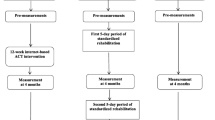Abstract
Patients hospitalized for coronary heart disease were offered a home recovery program utilizing the Internet. About one-half of the patients interviewed chose to enlist in this program. Participants and non-participants did not differ significantly according to medical risk and diagnostic factors, lifestyle and some demographic variables (principally marital status, sex, and race). However, those who owned personal computers and/or were familiar with the Internet, who were in higher socioeconomic strata, and were younger than age 65 were strongly more likely to participate. Internet instruction and computers (for those who had none) were provided to participants. Those who were lent computers—29% of the program participants—were more often female, without any college training, and less confident about using the Internet. As the public becomes increasingly more familiar with personal computer technology these potential barriers to its use may eventually disappear. The present study evaluated a fairly resolute method to introduce an Internet program to many recovering patients who were unfamiliar with this technology. However, other innovative and perhaps more aggressive ways of making those most in need of such valuable health-related information and resources can be tested in the near future.
Similar content being viewed by others
References
Andersson, P., & Leppert, J. (2001). Men of low socioeconomic and educational level possess pronounced deficient knowledge about the risk factors related to coronary heart disease. Journal of Cardiovascular Risk, 8, 371–377.
Cooper, R., Cutler, J., & Desvigne-Nickens, P. (2002). Trends and disparities in Coronary heart disease, stroke, and other cardiovascular diseases in the United States: Findings of the national conference on cardiovascular disease prevention. Circulation, 102, 3137–3147.
East Bay Business Times (2002). Home PC ownership stagnant. American City Business Journals, June 16.
Gustafson, D. H., Bosworth, K., Hawkins, R. P., Boberg, E. W., & Bricker, E. (1992). CHESS: A computer-based system for providing information, referrals, decision support and social support to people facing medical and other health-related crises. Proceedings—the Annual Symposium on computer Applications in Medical Care, 161–165.
Gustafson, D. H., Hawkins, R., Pingree, S., McTavish, F., Arora, N. K., Mendenhall, J., et al. (2001). Effect of computer support on younger women with breast cancer. Journal of General Internal Medicine, 16, 435–445.
Hollingshead, A. B. (1957). Two-factor index of social position. Yale Station, New Haven, CT. Author (mimeo).
Krantz, D. S., & McCeney, M. K. (2002). Effects of psychological and social factors on organic disease: A critical assessment of research on coronary heart disease. Annual Review of Psycholgy, 53, 341–369.
Marmot, M. G., & Bartley, M. (2002). Social class and coronary heart disease. In S. S. Stansfeld & M. G. Marmot (Eds.), Stress and the heart: Psychosocial pathways to coronary heart disease (pp. 5–19), Williston, VT: BMJ Publishing Group.
Morrell, R. W., Mayhorn, C. B., & Bennett, J. (2000). A survey of World Wide Web use in middle-aged and older adults. Human Factors, 42, 175–182.
Papakakis, M. C. (2001). The application and implications of information technologies in the home: Where are the data and what do they say? Arlington, VA: National Science Foundation, Division of Science Resources Studies.
Smith-Barbaro, P. A., Licciardone, J. C., Clarke, H. F., & Coleridge, S. T. (2001). Factors associated with intended use of a Web site among family practice doctors. Journal of Medical Internet Research, 3, E17.
Stamler, J., & Hazuda, H. P. (1995). Report of the Conference of Socioeconomic Status and Cardiovascular Health and Disease. Bethesda, MD: National Heart, Lung, and Blood Institute National Institutes of Health, November 6–7.
Acknowledgments
The authors gratefully acknowledge the contributions of Dr. David Gustafson and researchers at the Center for Health Systems Research and Analysis at the University of Wisconsin (Madison), who developed the Comprehensive Health Enhancement Support System (CHESS). The authors also wish to acknowledge the contributions of these Hartford Hospital employees: Cathleen Sauer, who produced the CHESS video; Jeremy Barbagallo, CHESS coordinator; and Jessica Sierra who provided data entry for this study.
Author information
Authors and Affiliations
Corresponding author
Rights and permissions
About this article
Cite this article
Steinmark, A.P., Dornelas, E.A. & Fischer, E.H. Determinants and Barriers to Participation in an Internet Based Recovery Program for Cardiac Patients. J Clin Psychol Med Settings 13, 353–357 (2006). https://doi.org/10.1007/s10880-006-9046-3
Published:
Issue Date:
DOI: https://doi.org/10.1007/s10880-006-9046-3




